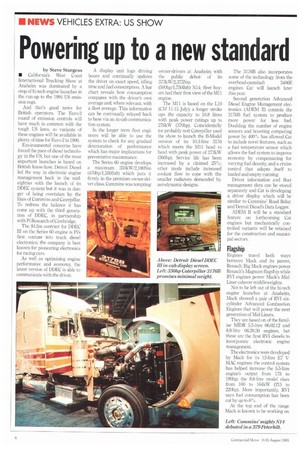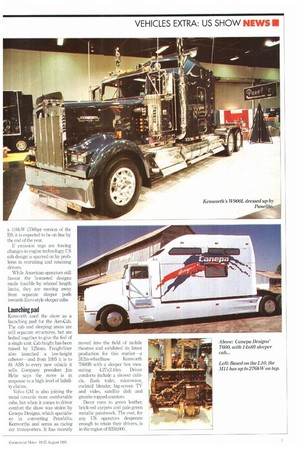Powering up to a new standard
Page 8

Page 9

If you've noticed an error in this article please click here to report it so we can fix it.
by Steve Sturgess • California's West Coast International Trucking Show at Anaheim was dominated by a crop of hi-tech engine launches in the run-up to the 1994 US emission regs.
And that's good news for British operators, The Euro-2 round of emission controls will have much in common with the tough US laws, so variants of these engines will be available in plenty of time for Euro-2 in 1996.
Environmental concerns have forced the pace of diesel technology in the US, but one of the most important launches is based on British know-how Detroit Diesel led the way in electronic engine management back in the mideighties with the launch of its DDEC system but it was in danger of being overtaken by the likes of Cummins and Caterpillar. To redress the balance it has come up with the third generation of DDEC, in partnership with Pi Research of Cambridge.
The $4.5m contract for DDEC III on the Series 60 engine is Pi's first venture into truck diesel electronics; the company is best known for pioneering electronics for racing cars, As well as optimising engine performance and economy, the latest version of DDEC is able to communicate with the driver. A display unit logs driving hours and continually updates the driver on exact speed, idling time and fuel consumption. A bar chart reveals how consumption compares with the driver's own average and, where relevant, with a fleet average. This information can be continually relayed back to base via an in-cab communication system.
In the longer term fleet engineers will be able to use the system to check for any gradual deterioration of performance which has major implications for preventative maintenance.
The Series 60 engine develops a maximum 350kW/2,100Nm (470hp/1,5501bft) which puts it firmly in the premium owner-driver class. Cummins was tempting owner-drivers at Anaheim with the public debut of its 373kW/2,373Nm (500hp/1,750Ibft) N14; fleet buyers had their first view of the M1 1 engine.
The MU is based on the L10 (CM 11-15 July); a longer stroke ups the capacity to 10.8 litres with peak power ratings up to 276kVii (370hp). Coincidentally (or probably not) Caterpillar used the show to launch the B-Model version of its 10.3-litre 3176 which meets the Mll head to head with peak power of 273kW (366hp). Service life has been increased by a claimed 25%; other mods include increased coolant flow to cope with the smaller radiators demanded by aerodynamic designs.
The 3176B also incorporates some of the technology from the overhead-camshaft 3406E engines Cat will launch later this year.
Second generation Advanced Diesel Engine Management electronics (ADEM II) controls the 317613 fuel system to produce more power for less fuel. Doubling the number of engine sensors and boosting computing power by 400% has allowed Cat to include novel features, such as a fuel temperature sensor which allows the fuel system to improve economy by compensating for varying fuel density, and a cruise control that adapts itself to loaded and empty running.
Driver information and fleet management data can be stored separately and Cat is developing a driver display which will be similar to Cummins' Road Relay and Detroit Diesel's Data Logger.
ADEM II will be a standard feature on forthcoming Cat engines but mechanically controlled variants will be retained for the construction and municipal sectors.
Flagship
Engines travel both ways between Mack and its parent, Renault. Big Mack engines power Renault's Magnum flagship while RVI engines power Mack's MidLiner cabover middleweights.
Not to be left out of the hi-tech engine launches at Anaheim, Mack showed a pair of RVI sixcylinder Advanced Combustion Engines that will power the next generation of Mid-Liners.
They are based on of the familiar MIDR 5.5-litre 06.02.12 and 8.8-litre 06.20.30 engines, but these are the first RVI diesels to incorporate electronic engine management.
The electronics were developed by Mack for its 12-litre E7 VMAC engines: the control system has helped increase the 5.5-litre engine's output from 175 to 190hp; the 8.8-litre model rises from 160 to 164kW (215 to 220hp). More importantly, RVI says fuel consumption has been cut by up to 8%.
At the top end of the range Mack is known to be working on a 410kW (550hp) version of the E9: it is expected to be on-line by the end of the year.
If emission regs are forcing changes in engine technology; US cab design is spurred on by problems in rearming and retaining drivers.
While American operators still favour the bonneted designs made feasible by relaxed length limits, they are moving away from separate sleeper pods towards Euro-style sleeper cabs.
Launching pad
Kenworth used the show as a launching pad for the AeroCab. The cab and sleeping areas are still separate structures, but are bolted together to give the feel of a single unit. Cab height has been raised by 125min. Freightliner also launched a low-height cabover—and from 1995 it is to fit ABS to every new vehicle it sells. Company president Jim Hebe says the move is in response to a high level of liability claims.
Volvo GM is also joining the trend towards more comfortable cabs, but when it comes to driver comfort the show was stolen by Canepa Designs, which specialises in converting Peterbilts, Kenworths and semis as racing car transporters. It has recently moved into the field of mobile theatres and exhibited its latest production for this market—a
312in-wheelbase Kenworth T600B with a sleeper box measuring 4.27x2.44m. Driver comforts include a shower cubicle, flush toilet, microwave, cocktail blender, big-screen TV and video, satellite dish and granite-topped counters.
Decor runs to green leather, brick-red carpets and pale-green metallic paintwork. The cost, for any US operators desperate enough to retain their drivers, is in the region of S250,000.
















































































